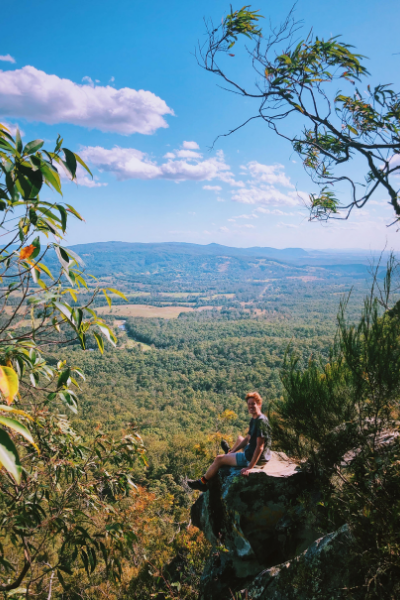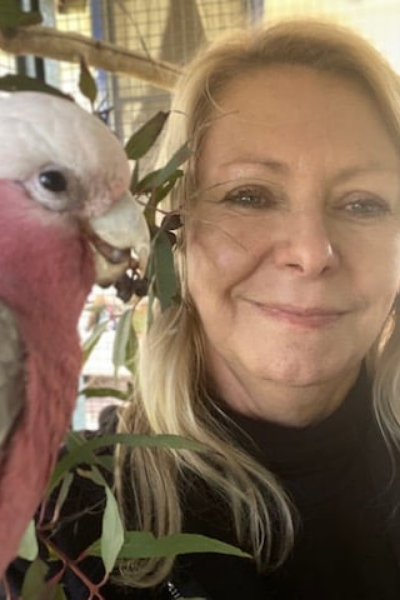
Meet the people who made their voice heard
Hundreds of supporters around Australia answered the call to make their voices heard and demand strong new nature laws. Every 10 years the Government is required to review the country's environmental laws, with the public able to make submissions into the review process. It represents a once-in-a-decade opportunity to deliver strong protections for nature. Here, meet five supporters who took the time to tell the Government how and why the EPBC Act needs to change.
Yvette's Submission

"My name is Yvette Nirvana. I am a mother of three and have seven grandchildren. When my children were growing up I took them for walks in the nearby Kondallia National Park, Mapleton National park and others. I wished to instil a love of nature and the environment in my children. I’m afraid my grandchildren won’t have that experience.
As I child I lived in New Farm in a flat and had no experience of nature except going on day trips with my father to Mt Cootha or other local areas. Life in the city was miserable.
At 29 I had the opportunity to move to Flaxton near Montville and discovered a peace that could only be found in nature. I spent 15 years planting trees including natives, to restore a cleared grass property that we lived on. I was rewarded with birds and wildlife flocking onto our property. At my local school, I was involved in eco-education and started a permaculture garden that still continues. It is now a Stephane Alexander supported garden, Montville State Primary.
After 19 years in Montville, I moved to beautiful Stradbroke Island. I started a boomerang bag branch there. On the opening night, a scientist from the UQ branch on Stradbroke gave a talk. She showed us the plastic that was found inside turtles and fish. Minjerribah is a rare paradise teeming with wildlife. I have personally seen whales, dolphins, turtles, kangaroos, koalas, snakes, a massive bat colony and a huge variety of birds. It is so close to Brisbane and was something we all felt worth protecting. Unfortunately, visitors to the island bring dogs that attack wildlife. They also drive too fast and hit animals. Jade the only vet on the island is frustrated. Laws need to be put in place and policed.
When I heard about the Toondah Harbour development I was dumbfounded. The wetlands are RAMSAR acknowledged. Internationally acclaimed. The community are clearly against the development and are not being considered. Migrating wading birds need to feed and rest in this area, including the critically-endangered Eastern Curlew. I have signed petitions that seem to go nowhere. The animals and eco-systems will die without the mangroves.
Why must the people fight against the government? The government should represent the health of the people in the long term and therefore should listen to them, for the sake of future generations. This is not possible without an independent environment protection body looking out for our environment with no strings attached.
Science experts should be considered not politicians. Then laws put in place and followed through to protect the environment in all ways.
I call on the government to:
- Establish an independent National Environment Commission to develop a coordinated system of environmental protections necessary.
- This organisation needs to report to the public regularly, so we can see the success or failure of the policies.
- The government needs to provide resources and money for successful environmental care.
Thank you for the opportunity to voice my opinion.
Yvette
Mitchell's submission

My name is Mitchell Snow, I live in Brisbane and am studying a Bachelor Economics at the University of Queensland. I have lived in Brisbane since 2017, but before then I grew up in Gladstone, Central Queensland. I spent the vast majority of my life in Gladstone and witnessed drastic industrial change with devastating consequences to the surrounding environment.
Environmental degradation is wide-spread and apparent. The expansion of the port of Gladstone required heavy dredging which contaminated the harbour water with aluminium, copper and arsenic. The dredged harbour caused debilitating diseases in marine life. It made most of the animals inedible, forcing local fisherman to source animals from out of town.The Gladstone Power Station is the largest in Queensland. Each time I walked out onto my deck the soles of my feet would be jet-black with coal dust. The associated air pollution is a long term health risk to locals.
Lastly, when driving anywhere out of town you can fields-upon-fields of felled trees. Queensland has one of the highest deforestation rates in the world, on par with the Brazilian Amazon. Australia as a whole is among the 11 worst nations when it comes to deforestation. With land clearing being the predominant cause of Australia having the highest mammal extinction rate in the world..The extinction of species and destruction of the environment is preventable.
Current issues with the EPBC Act include:
- Scope is only “matters of national environmental significance” and that land clearing and climate change are not included in the list of such matters, and are usually considered under state laws. There needs to be a strong national framework in place to tackle these problems.
- The decisions related to the EPBC Act are subject to political pressure and ministerial discretion, undermining the integrity and effectiveness of the laws.
What I would like to see:
- Establish an independent National Environment Commission to ensure the development of both state and federal environmental policies desperately needed to support the restoration of our environment prevent against future impacts. Including and public, annual progress report on the impact of conservation action and funding, and show clearly whether natural values are recovering.
- Establish a new National Environment Act that contains real and enforceable safeguards against extinction, including ending the destruction of endangered species habitat, and sets out clear rights of appeal and consultation for communities. Placing emphasis on damage prevention, rather than damage control.
- Establish and fully fund an independent Environment Protection Agency to act as watchdog over the system and ensure our laws are properly enforced. Thus eliminating party biases and promoting evidence-based action.
- Develop and implement enforceable, well-resourced recovery plans for threatened species, as the act has not slowed the extinction rate.
Thank you for your time and consideration,
Sincerely,
Mitchell.
Atholie's Submission

My name is Atholie Harden and I am passionate about the Australian wilderness and wildlife. I am treasurer of a small wildlife rescue and rehabilitation group in Williamstown, Victoria, called Western Animal Rescue, and a member of The West Wilderness Society group.I have been running a small wildlife shelter in Williamstown for the past 13 years. I am required to respond to calls for assistance from local vets, local council, community members, Wildlife Victoria and other organisations which provide emergency phone advise to the public in relation to injured and orphaned wildlife.
This work, which is voluntary, exposes me to the enormous pressure placed on urban wildlife by urban development and population expansion. It is not uncommon to be called to assist many species, including echidnas, kangaroos, wallabies, seabirds (including penguins), land birds, possums and reptiles which have been displaced by developments and find themselves in schools, warehouses, parks, housing developments or even completely landlocked by building developments and cyclone fences. This, in addition to wildlife misadventure related to human interference and vehicle accidents make up the majority of rescues and rehabilitations With which I work.
I love having the training and ability to help wildlife and to have close contact with them, especially the bitter/sweet experience of being able to release them back to their home environment when possible. Unfortunately more animals are euthanised, as the result of their interactions with humans, than can be saved.
I also spend a lot of my time at our farm near Shepparton, in north central Victoria. We plant many native trees in an effort to encourage and provide habitats to the local bird and animal life and to absorb and store carbon dioxide emissions. Rural activities are very hard on wildlife. Land clearing, cultivation, running stock, fencing, herbicides and pesticides all interfere with their ability to thrive and to breed. Add to this the ongoing effects from drought and climate change and many species’ numbers are declining dramatically. Twenty years ago we enjoyed many species of small birds here. Now many species, zebra finches for example, have completely disappeared or their numbers reduced dramatically. It is well documented that birds are indicators of environmental health which will ultimately affect human life also, (Gregory and van Strien, 2010).
I am frequently disgusted to hear about farmers shooting and poisoning wildlife and destroying their habitats. One example is of farmers, with or without permits, excavating and then burying wombats in their burrows, leaving them to die a slow agonising death by suffocation. As in so many such instances, this could be so easily avoided by fencing off the burrow area and cropping around it, as one might a large red gum tree. Wombats always return to the same burrow so a workable compromise can easily be made.
It is only a matter of time before wombats suffer the same risk of extinction as koalas currently face. Many decades of urbanisation and habitat destruction and then the recent bushfires have added uncertainty to the future of both these iconic Australian animals. Koalas also suffer from chlamydia and wombats suffer from mange; devastating diseases which lead to slow and painful deaths. To keep these animals, which are a part of the Australian cultural identity, we need strong laws and vigilant enforcement with appropriate penalties for those who break these laws.
We love to stay in ApolloBay and enjoy the natural beauty and peace of the beaches and the Otway Ranges. The beach is sadly eroding, largely as the result of climate change (Victorian State Government, 2020). Frequently last summer, trucks carried sand from one end of the beach to the other in order to stave off erosion of the Great Ocean Road and to maintain some beach line (Paul, M. 2017).These, largely futile or at best short term solutions, had some serious side effects.
The hooded plover, which is a vulnerable species in Victoria, already struggles to survive and breed in the summer months, amongst the numerous tourists, beach goers and their dogs who inadvertently step on eggs and frighten plovers off their nesting scrapes in the sand. In addition to this they are subject to predation by foxes. Volunteers have worked hard and donated their time and money to try to save this species however with the added disruption by earthmoving trucks, I fear for their future and imagine they will become yet another extinction in Australia. The sand could be moved from one end of the beach to the other via the road, however the decision to drive huge trucks up and down the beach was made without community consultation.It would be inconvenient to use the road, however if all decisions about the environment continue to be made purely on the basis of convenience and economics, the environmental consequences will continue to spiral downwards.
Since then the beach is being bolstered with rock which once again requires sand to cover it. This time the community consultation has resulted in volunteer being present to observe and to attempt to protect the plover. Too little too late, I suggest.
Professor Lesley Hughes from the department of biological sciences at Macquarie University believes, “the whole system is completely broken” (Cox,L. 2018). In the light of the devastation to wildlife and forests during the most recent fire season, it is imperative that stronger laws be enacted to curb the devastation of the unique Australian environment and further extinctions.
Companies with large pockets take advantage of weak laws and gain easy approvals or exemptions from attempts to protect the environment.The EPBC Act should be serving to save species not acting to streamline their extinction. Any development or approval for logging or any other human activity should receive the strictest scrutiny and only be approved if there is certainty that loss of habitat or species can not occur as a result. What is more, companies should be given the responsibility to actively protect environmentally sensitive sites they are exploiting.
It is alarming to think that old growth forests are still being logged in Australia when it is clearly resulting in destruction of habitats and species close to the brink of extinction. One such species is the leadbeater possum which is the fauna symbol of Victoria.
WHAT NEEDS TO CHANGE.
- I believe that the current EPBC Act fails to protect the Australian environment.
- Much stronger laws are required along with much greater scrutiny and transparency.
- Developers and governments must not be allowed to get rubbers stamped approvals for activities which harm the environment any longer.
- New laws must be strictly enforced by a truly independent body who are bound to report conflicts of interest. This body must have power to act in the interests of the environment and the people and not just be a toothless tiger.
- New laws must always include recovery plans for species, forests and waterways. These should be factored into the costs by developers and governments in the planning stages.
- Community views must be considered always and regardless of where someone lives. We all deserve a say in what happens to the Great Barrier Reef, for example, not just those living in that are.These are culturally significant sites and reflect on our Australian identity.
- The Australian environment is under attack from all sides and radical changes to the EPBC Act is our only hope to begin to counter the damage already done let alone what is ahead from Climate Change and the next bushfire season (just months away). Immediate action is required and without this Australia has a future as an uninhabitable dust bowl.
Thank you for your consideration of my submission
Atholie
Alec's Submission

I live in the Lake Macquarie / Newcastle region in NSW. I work for the University of Newcastle, School of Environment and Life Sciences as a Project Officer and previously worked at the Tom Farrell Institute for the Environment. My current role involves conducting an environmental assessment for Norfolk Island. In a volunteer capacity, I am a committee member of several organisations including:
- the Hunter Environmental Institute
- Richmond Vale Rail Trail Inc.
- Newcastle Climate Change Response
- Hunter Innovation and Science Hub
- and the Clean Energy Association of Newcastle and Surrounds.
I am also a member of the Charlestown chapter of The Wilderness Society. I am involved in what could be termed environmental outreach, informing the public on environmental information, news and activities through newsletters, conducting seminars, events and conferences. I have helped run the annual Mined Land Rehabilitation Conference and the Hunter Valley Electric Vehicle Festival over the last 4 years. On the ground I am involved with Landcare work for the Richmond Vale Rail Trail.
The EPBC Act is 20 years old and has failed to address the loss in biodiversity and extinction prevention of plants and animals or habitat destruction within Australia. The Act is complex and unwieldy and is in drastic need of reform. The Act needs to address the environmental threats that we face including climate change and habitat destruction through land clearing.Rather than amending and modernising the Act, a new Act should be drafted with biodiversity conservation and environmental protection being the key drivers.The new Act should provide government leadership on environmental protection, include safeguards for plant and animal extinction including stopping habitat destruction of endangered species, and to increase resilience of plants and animals and their habitats to key challenges such as climate change.
The principle of Ecologically Sustainable Development is a key aspect with the Act and should be modernised and strengthened to include principles of continuous improvement and non-regression of environmental standards, goals, and policies; achieve high levels of environmental protection through best practices; and increased resilience to climate change and other pressures on the environment.
With my involvement with the Mined Land Rehabilitation Conference I have seen the effects of cumulative approvals of mines and mine expansion in the Hunter Valley on the environment, the decreased resilience to change, the health impact on individuals living and working within the area. For example, there is a cumulative issue relating to air quality in the Upper Hunter that needs attention. Average levels of coarse particle pollution in the Hunter Valley have increased at a rate higher than the rest of NSW. Air quality in the local area has been deteriorating over time, reaching 470 air quality alerts in 2019 prior to the bushfires. The top three for PM10 particulate levels of air pollution in NSW are in the local area. This air pollution contributes to heart disease, stroke, deaths, diabetes, low birth weight for babies, restricted lung growth in children, lung cancer in non-smokers, asthma and emphysema. A planned expansion of the Glendell Mine this year in the area would exacerbate an already dire set of circumstances with respect to air quality and health issues in the local area. However, the mine expansion went ahead as cumulative impacts are not considered in planning laws. The Act needs to explicitly consider cumulative impacts of past, present and future developments and decisions. The use of strategic environmental assessments may assist in assessing cumulative impacts.
The impacts of climate change on the environment are significant and severe. The present scientific consensus is that the earth's climate is warming due to human activity, and the negative impacts of increased greenhouse gas emissions are measurable globally and nationally. The government is responsible for the environment, the health and wellbeing of its citizens, and the financial security of the nation. As we see the impact of increased carbon emissions, we also find evidence of the impact on Australian native wildlife, the Australian people and the wealth of the nation as noted by the recent catastrophic bushfires and devastating drought.
To ensure the health and resilience of the Australian environment and its people in the face of such challenges, laws and processes will need to be enacted to mitigate climate change and address the impacts of climate change, extreme weather and drought. This would include sustainably managing environments affected by climate change and rebuilding and restoring ecosystems burnt by bushfires. Although climate change is the most significant environmental threat it is not mentioned anywhere in the Act. The Act should address and regulate the impacts of climate change on biodiversity.
For example, following the recent catastrophic bushfires, koala populations are at a crisis point and it is imperative that urgent action be taken to ensure the survival of this iconic species within south eastern Australia.
Climate change is predicted to affect koala habitat conditions and cause more severe weather conditions (such as the recent severe drought and catastrophic bushfires) which will impact koala survival rates. Climate change is predicted to affect koala habitat by altering the structure and chemical composition of koala food trees, changing the composition of plant communities, and changing the range of important habitat species.
In my local area, changing sea levels as a result of climate change will impact on low lying priority habitat, within the Port Stephens area and Stockton Bight, further fragmenting habitat stands. The ability of Koalas to migrate due to the effects of climate change are impacted by the connectivity across the landscape. Particular attention is required to remove or mitigate the barriers to connectivity and to preserve and enhance existing connectivity, such as undertaken in the Hunter Valley with the Great Eastern Ranges initiative. For example, regional and local conservation planning should consider protecting existing connectivity and enhancing connectivity of koala habitat patches that are within 100m of another patch.
Climate change considerations need to be included in the Act to identify and protect habitat and corridors that will support species resilience to more extreme heat and natural disasters, even if there is no population in those areas now.
Matters of national environmental significance (triggers) are an essential part of the Act that trigger assessment processes under the Act. These triggers should be retained and expanded to include vulnerable ecological communities (alongside other threatened specifies and ecological communities), significant land-clearing activities, significant water resources (in addition to coal seam gas and large coal impacts)., the National Reserve System, significant greenhouse gas emissions and nationally important ecosystems (key biodiversity areas and areas of high conservation value).
Any biodiversity offsetting must be based on clear scientific principles and limits and maintaining or improving ecological outcomes. The government should avoid lowest common denominator standards that rely on the market such as with the NSW system. The Act should not allow ‘offsetting’ critical habitat, endangered species and ecological communities. Furthermore, offset land should be of similar habitat (like-for-like), should provide an improvement for the impacted species or ecological community, must comply with the provision of no net loss of biodiversity, must be protected in perpetuity, should be consistent with any species recovery plans, cannot be substituted by the payment of money, such as into a Biodiversity Conservation Fund, and should be a last resort following efforts made to mitigate impacts.
Offset land must be an additional protection. For example, a developer cannot use existing parkland to offset koala habitat such as was proposed by Lendlease near Campbelltown in NSW last year.
From my personal experience with the Mine Rehab Conference, Mine Rehab land is unlikely to be an effective offset (in line with like-for-like habitat, no net loss of biodiversity, etc) and should be excluded. The former NSW Office of Environment and Heritage noted that “there is no certainty that functioning ecosystems can be restored to their original value through rehabilitation” and questioned whether restoration of biodiversity on a degraded site was even possible.
Offset land must be secured prior to development / land clearing going ahead. For example, after seven years and multiple time extensions, Whitehaven’s Maules Creek mine has failed to secure over 5000 hectares of biodiversity offsets for their clearing the critically endangered box gum grassy woodland ecological community near Narrabri and is now in court. Only 5% of this iconic woodland still exists and provides habitat for the Regent Honeyeater, Superb Parrot and Squirrel Glider.
Ecosystem services underpin human existence, health and prosperity, with biodiversity central to the production of ecosystems services. In recognising the intrinsic importance of the environment to Australia, the Act needs to acknowledge the value of ecosystem services. The assessment and value of ecosystem services also needs to be included in decision making to ensure potentially hidden social costs or benefits are considered.
To ensure government accountability and effective decision making, greater public transparency is required together with effective community consultation and the right of appeal. Decisions should be informed by community engagement (including public submissions) and the reasoning behind the decisions documented and provided back to the community. Specifically, the Act should provide information on policies, policy changes, and specific assessments, decisions and actions to the public in a timely and accessible manner. It should not be necessary to undertake lengthy and expensive FOI requests to get the reasoning behind decisions. The right of appeal should extend to the courts with judicial review of government decisions such that is available in the states. Similarly interested parties should be able to seek merits review of decisions.
To facilitate reform and effectiveness of the new Act, a national ecosystem assessment should be undertaken to establish a baseline and determine indicators of success/failure. National ecosystem assessments could then be undertaken periodically to help measure, maintain, and improve environmental outcomes.
To improve governance, a new national Environmental Protection Authority (EPA) needs to be established as the chief environmental regulator and to assess and approve projects, monitor compliance and take enforcement action. Furthermore, a new National Sustainability Commission be established to set national environmental goals and standards, coordinate national plans and actions, develop policy responses to current and future environmental impacts and in light of scientific evidence, and publicly report through Parliament each year on the state of the environment, impact of actions and environmental outcomes. The government should be required to respond to these reports.
And finally, resourcing has been a constant issue for the effective implementation of the Act. Government funding should be increased to enable this, such as resourcing to enable the effective implementation of environmental protection and restoration, and the listing and conserving of threatened species and ecological communities.
Thank you for your consideration of my submission
Sincerely,
Alec Roberts
Chair CLEANaS